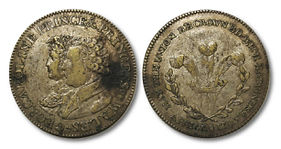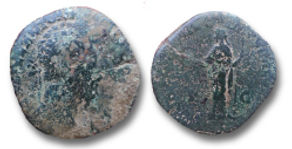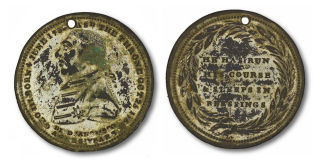
Who are the Moravians?
Chippenham & District Metal Detecting Club Support a Local Heritage Project
I asked myself this very question in February when the Chairman of the East Tytherton Heritage Project approached me for assistance. Nigel has sought me out through the Chippenham & District Metal Detecting Club (CDMDC) website to ask whether the club would support an ongoing initiative to add some historic context to an already established local research project. Eager to learn more, I gleaned as much background information as possible to understand the scope of what he was asking and concluded that the club would likely approach this request with enthusiasm. Nigel had already committed vast amounts of time to the project and, consequently, a wealth of background information was available through his study. In summary, our task was to metal detect around the Moravian church, burial ground, school and adjacent ground to see if we could recover any artefacts that would support and inform further on his work.
So, where on earth is Moravia and why did the Moravian church teachings take hold in a tiny Wiltshire village? Moravia, named after the River Morava, is a historical region within what is the eastern part of the Czech Republic and one of the historical Czech lands, together with Bohemia and Czech Silesia. It had a turbulent history under various empires and was eventually dissolved as a land in 1949. The Moravian Church considers itself to be the oldest protestant denomination having been founded in 1457. For reference, you can compare this date with the mid-16th Century English reformation under Henry VIII which occurred some 100 years later!
The Moravian Church has long been associated with cross-cultural missionary activity and came to Britain during the colonial period. Other missionary efforts expanded into Greenland, Labrador (to the Inuit people), Surinam, Guyana, South Africa, the native tribes of North America and the Caribbean (largely to the African slave population there). Of national importance is the gravestone of Antiguan slave Leonora Casey Carr lies in the village - the only grave known of an ex-slave in Wiltshire.
John Wesley [Fig 1], commonly accepted as the founder of Methodism, was greatly influenced by the Moravian church. The Moravian Church in East Tytherton owes its existence to a man named John Cennick [Fig 2], an eighteenth-century evangelical preacher who worked for a while alongside John Wesley in Bristol and was probably his first local preacher. Afterwards he concentrated on the Wiltshire area, preaching and forming societies in several local towns and villages.
So, history lesson aside (noting that we have barely scratched the surface], I made the proposal to the CDMDC at the next meeting and was greeted with unanimous support. It was agreed that any finds made would be researched and returned to the project in order to Nigel to investigate and introduce into the historical record. 30th March was the date set with preparations made, permissions acquired, and the club detectorists briefed.
The day arrived and the weather could not have been better; bright, sunny and warm enough for t-shirts. Nigel greeted us on arrival and, as only three of us had participated in the recce, he went on to provide a thorough tour of the detecting grounds [Fig 3] for those of us who were new arrivals. These included the Moravian cemetery, the church grounds, the old school gardens (now a residential property) and a neighbouring Girl Guides playing field that was used in Georgian times for outside preaching. The group, in total 11 of us, was divided across the various areas and detecting commenced.
The cemetery area proved relatively difficult to detect on given the number of ancient trees and associated root system. Furthermore, the ‘laid flat’ style gravestones restricted detecting areas, therefore little was recovered. For a different reason, the Girl Guides’ playing field yielded little of value in terms of adding context to the religious activities of the Georgian period. What it did yield, however, was plenty of post-decimal coinage that was testament to it’s use over the past 50 years or so. There were a few exceptions; Terry, the club chairman, recovered some Victorian pennies and I was lucky enough to unearth a George I ‘Dump Issue’ ha’penny [Fig 4] and a lovely condition Half-Crown [Fig 5] of George V. Could the ha’penny have been dropped by a member of Cennick’s congregation? Perhaps. Just prior to abandoning the field and straying over a thousand years from what we were expecting, out popped a Saxon stirrup mount [Fig 6]. Off to the FLO for confirmation and recording.
By far the more fruitful ground was the lawns before the church. Finds there confirmed the Georgian context and activities that took place there. Thimbles, lots of them, were repeatedly unearthed suggesting the womenfolk would have been working outside mending, darning and perhaps making clothes. My favourite find of the day came early; a King George IV & Caroline Prince & Princess of Wales marriage token [Fig 7]. This was issued to commemorate the king marrying his first cousin Caroline of Brunswick in the Chapel Royal, St James’s Palace, on 8th April 1795. Shortly after bringing that to the surface another welcome surprise popped up in the form of a William III love token. Most established detectorists will know these well; often a worn sixpence bent into an ‘s’ shape. This one, however, had been bent on 4 sides which is a first for me [Fig 8]. Back in olden times it was common practice to give your sweetheart a worn and bent coin, sometime engraved with initials or symbols of love. If she kept it the feelings were reciprocated. If she threw it away it was time to move on. Going by the number of love tokens found by detectorists I guess there were a lot of disappointed young men…
By now word had spread across the various grounds that the land in front of the church was producing more relevant finds and before long the majority of us had congregated in this area. An abundance of 18th & 19th century coins were recovered along with the odd surprise. It was not expected that we’d find, 8 inches under the lawn, a 2nd Century Roman coin [Fig 9] of perhaps Antonius Pius or Marcus Aurelius. Unsurprisingly it was our club’s ‘Roman Magnet’, Mark who found it. No-one can match him in finding artefacts from this period when he switches on the trusty old T2 complemented by his ‘dustbin-lid’ coil. Whether this coin was genuinely was lost in situ some 1800 years ago or brought here in some topsoil during post-medieval landscaping we’ll never know. But we can always dream.
During ‘time out’ Nigel and others involved in the project kindly laid on tea and biscuits in the church rooms alongside a presentation [Fig 10] he had made explaining everything the project had learned over the years. Nigel and his colleagues had clearly invested significant time and effort in painstakingly researching the village’s history in articulate detail with numerous charts, booklets and pamphlets. Part of the church’s story is that it’s the resting place of an Antiguan ex-slave girl named Leonora Casey Carr. It is the only grave known of an ex-slave in Wiltshire.
Back to the grindstone and finds continued to surface, including a George III death commemoration medallion [Fig 11] and what appears to be either a dog or hawking whistle [Fig 12]. My silver trophies came along in the form of a couple of George V coins; one mentioned early along with a lovely Threepence [Figs 13]. Not all that old but nice all the same and confirmation of the church’s post-Georgian & Victorian use. I also had a shot in one of the villagers’ gardens nearby and brought to the surface a 16th Century Nuremberg Jeton and [probable!] Edwardian religious pendant [Fig 14].
As the day drew to a close digging tools were holstered, and detectors packed away. The NCMD Western Region representative and close friend of the club, Andy, presented Nigel with a keepsake to remind him of the day [Fig 15] which had proved to be very successful in that it helped develop further the hard work Nigel and his team had done. All finds will be cleaned, identified, recorded and prepared for display [Fig 17]. We look forward to working with the project again in September.


fig 3 - nigel briefing the detectorists
fig 10
presentation board

fig 1 - john wesley

fig 2 - john cennick

fig 4 - 'dump' halfpenny

fig 5 - GEORGE V HALF CROWN

fig 6 - saxon stirrup mount

fig 7 - king george iv marriage token

fig 8 - love token

fig 9 - roman coin

fig 11 - george III
death commemoration medallion

fig 12 - whistle

fig 14 - religious pendant

fig 13 - george V threepence

fig 15 - andy presenting nigel with a commemorative plaque

